The special exhibition “Sudo Reiko: Making NUNO Textiles” was held at Marugame Genichiro-Inokuma Museum of Contemporary Art (MIMOCA) from Sunday, October 8 to Sunday, December 10, 2023. This exhibition was originally organized and held at CHAT (Centre for Heritage, Arts and Textile) in Hong Kong in 2019. After touring Europe, it held its fifth opening at MIMOCA. Although a traveling exhibition, the exhibition featured two new works by Sudo, viewable only in Marugame, when staged at the MIMOCA venue. In this writing, I will introduce one of them, Big Pastel Drawing.
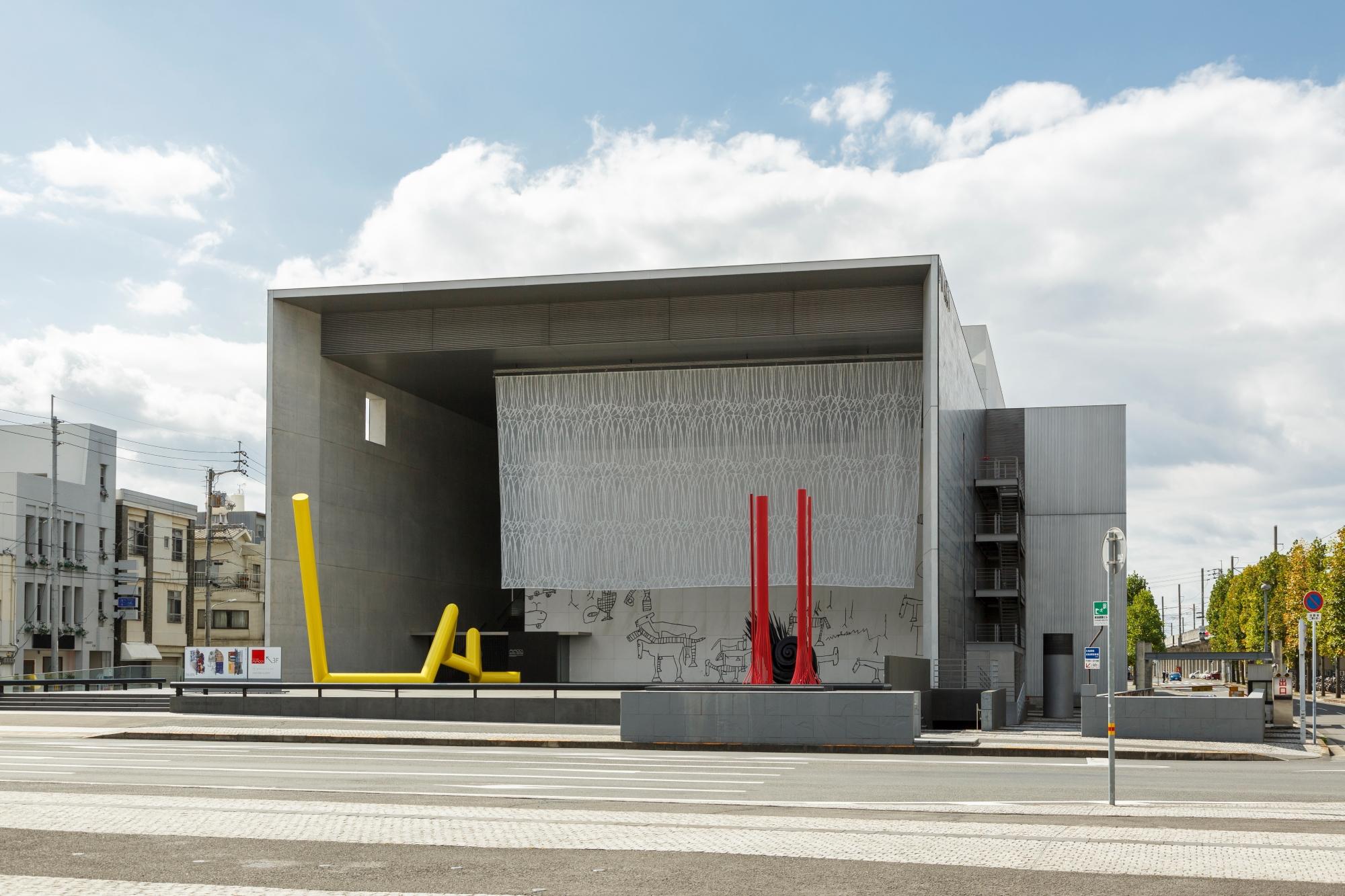
Reiko Sudo, Big Pastel Drawing, 2023 photo by Manami Takahashi
New Work 1: Big Pastel Drawing in Gate Plaza
Viewed from the front, the MIMOCA building appears as a large, square box, open in front. Because it is located about a 1-minute walk from JR Marugame Station, people visiting Marugame by train see this large box immediately on leaving the station. Displayed deep in the box-like space is Genichiro Inokuma's 21.5-meter-wide, 11.5-meter-high mural Creation Plaza (1991), which has been MIMOCA's face to the world since its opening. The overall box-like space is called "Gate Plaza" at MIMOCA.
When visiting MIMOCA in spring 2022 in preparation for this exhibition, Reiko Sudo felt inspired by Gate Plaza's space and desired to exhibit some kind of large textile there. In her mind, she imagined the textile as loosely connecting the museum and station and welcoming visitors exiting the station into the museum.
The aforementioned Inokuma mural established in Gate Plaza is a distinctive drawing displaying motifs such as horses, trees, and helicopters rendered in black lines on a white background.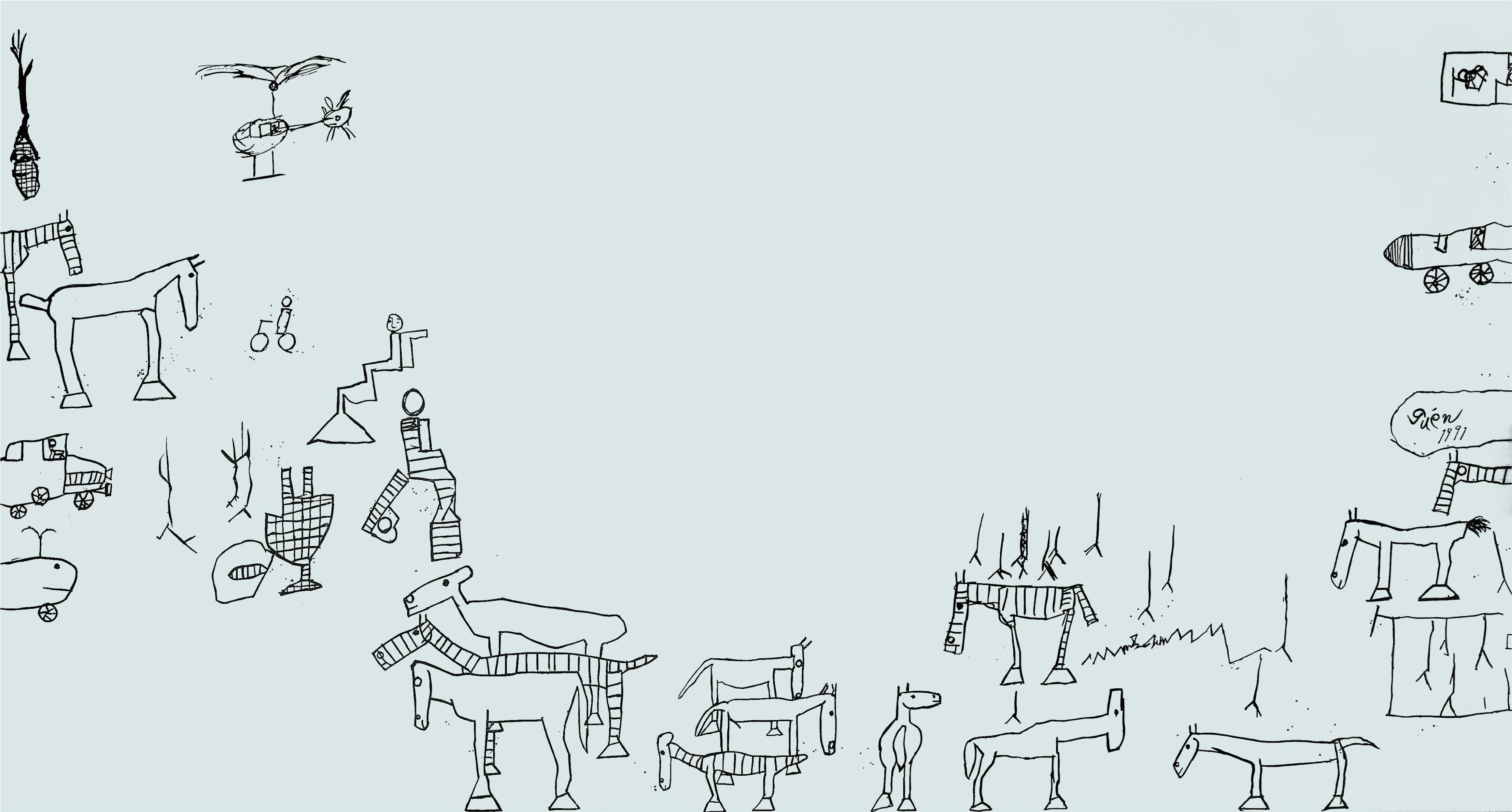
Genichiro Inokuma, Creation Plaza, 1991
In response to this mural by Inokuma, Sudo took a pastel and, moving her hand in a spiral, drew a line emerging naturally from her arm and body on paper. After drawing many lines in this way on sheets of paper, she chose one of them to be her original image.
To convert such a drawing to an image on a digital grid and enlarge it to actual size, increasing the resolution all the while, requires an enormous number of pixels. Since pixels are square, the curves they display inevitably appear jagged. From what I hear, Sudo carefully checked each pixel one by one in consultation with an engineer to determine whether it was a line pixel or background pixel. It must have been arduous work, for the image consists entirely of curves.
The digitized drawing was printed on sheer white organdy using the hand-printing method of flocking (glueing short fibers upright on fabric). A two-meter-long pattern was required for the hand-printing stencil. Since the printing is ordinarily a one-person operation, however, even a large stencil must be short enough to be workable by stretching out one's arm, so the use of a two-meter stencil was initially judged to be impossible. In the end, it became possible to print with a two-meter stencil by having two people work in sync as a pair. A new technique was thus born from the creation of this work.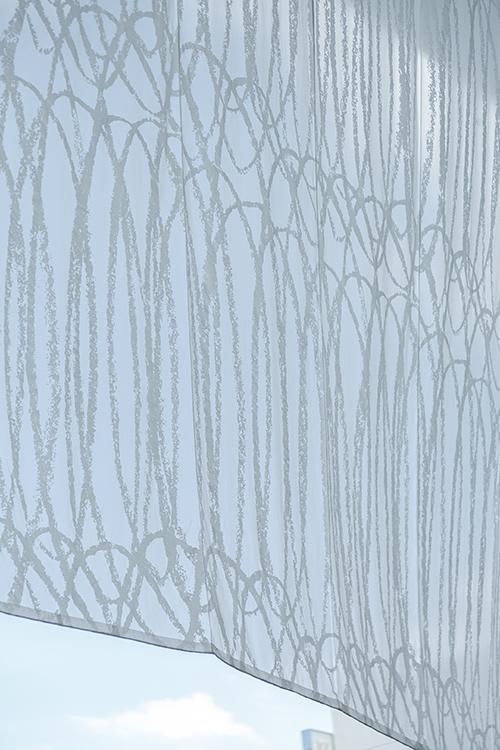
Back view of Big Pastel Drawing photo by Manami Takahashi
The large textile, 18.9 meters wide and 9.6 meters high, is an assembly of 15 fabric pieces, each over 1.2 meters wide, sewn together (the seams also being beautiful). It was folded compactly and delivered to the museum in a cardboard box. Upon removal from the box, the glossy white textile was lightly spread like a wedding dress. When hung in Gate Plaza, there was spontaneous applause.
Reiko Sudo's Big Pastel Drawing has a number of points in common with Inokuma's mural.
One concerns the motif. Although Creation Plaza features figurative motifs such as living creatures and man-made objects, Inokuma in fact originally had in mind an abstract painting with circles and X's. By displaying a picture of circles and X's in the entrance that even small children would be capable of drawing, he wanted regional people to think, "I can draw like that" and "Art is not complicated." On the other hand, he also wanted to convey that it is an artist who can create a proper "artwork" for this large space using only circles and X's, and that this art museum exhibits such "artworks." In the end, Inokuma created the current mural depicting living creatures, but according to him, "I drew it like graffiti to express my feelings for Marugame, the land of my childhood, and my hope that everyone will want to paint" ("Marugame Genichiro-Inokuma Museum of Contemporary Art. The artist and others unveil a large mural," Shikoku News, March 26, 1991). We sense in his words a strong will to carry through the intention behind his original scheme of circles and X's. 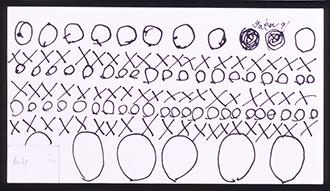
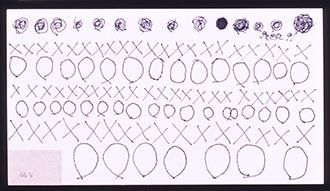
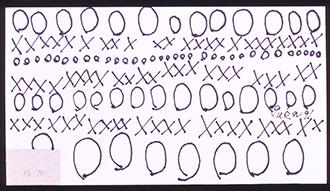
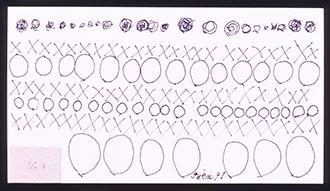
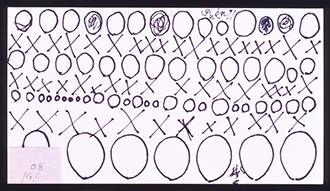
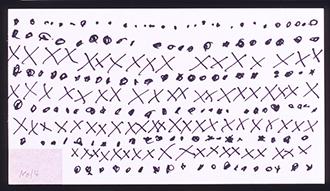
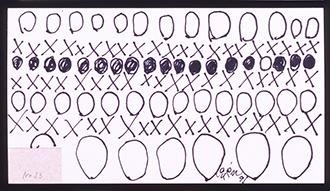
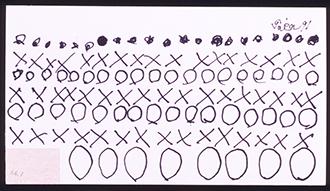
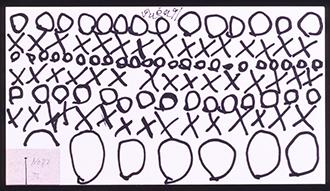
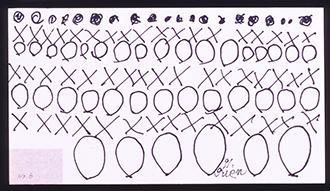
Genichiro Inokuma, Drawings for the Mural of MIMOCA, ca. 1990
Sudo was unaware of Inokuma's plan for a picture with circles and X's. On seeing his graffiti-like motifs, she simply felt inspired to draw a large spiral line. Precisely like Inokuma's circles and X's, it forms a picture that anyone, children and adults alike, might draw. Moreover, as a world-leading textile designer, she has created a unique work that melds with the space.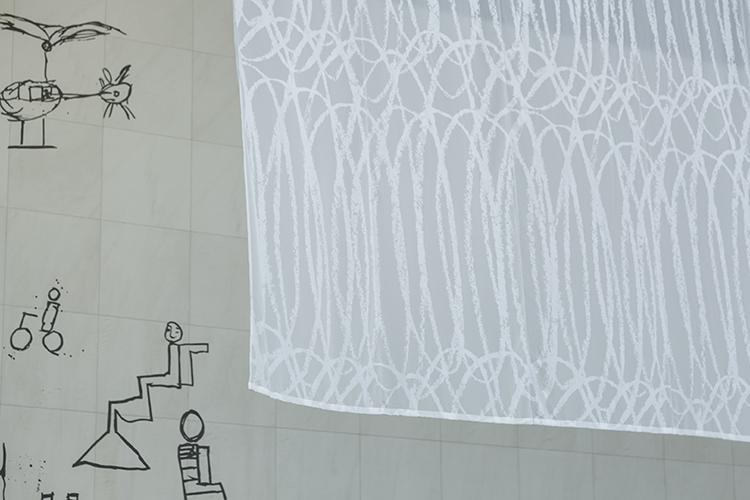
photo by Manami Takahashi
A second point concerns the production process. The line drawings of Inokuma's mural are in fact inlays. They were recreated by embedding crushed black granite into a white marble background. Just as Sudo's lines are a collection of tiny pixels, Inokuma's lines are a collection of tiny stone pieces.
To create the mural in 1991 without relying on a personal computer, the small original drawing was repeatedly copied and enlarged to full size. The more it was enlarged, the more blurred its details became.On seeing the test product, it is recorded, Inokuma frowned and repeatedly remarked that "(the lines) have become round (curved)." He must have felt that it was no longer his own line, no longer his own work. He therefore spread the full-size enlarged copy in a large gymnasium-like space and repainted its lines with a thick brush. In this way, the artist's powerful brushstrokes came be expressed in the mural as they originally were. He sometimes deliberately shook the brush to make paint splashes, which were also faithfully reproduced in the inlay.
In effect, Sudo's line corrections were the opposite those of Inokuma. The curves formed by tiny pixels appeared jagged, so she checked and recreated them one by one to form natural curves. In intent, however, the two artists shared in common a sincere, uncompromising attitude of not simply enlarging the original to actual size but carefully checking its details and making modifications to complete the work.
Big Pastel Drawing waves gently in the natural breezes passing through Gate Plaza. There are times when it flutters dynamically and there are days when it hangs quietly, but one never tires of watching, because it never moves the same way twice. Sudo describes its movement as "the wind in a visible form." The work, she concludes, is "a form created entirely by nature."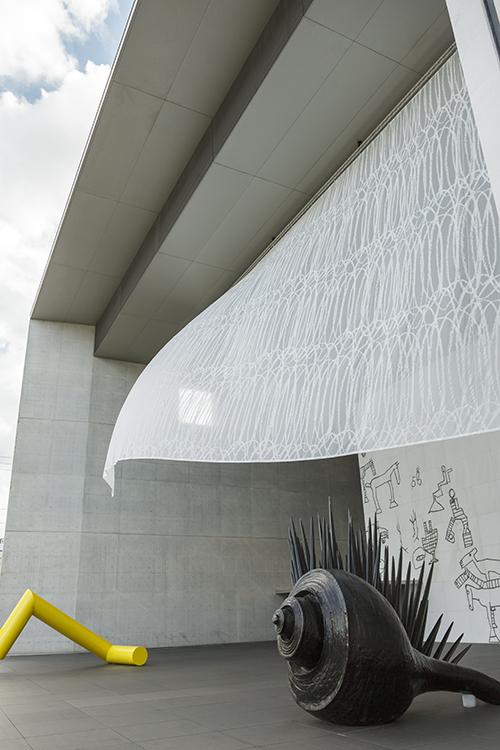
photo by Manami Takahashi
Reiko Sudo, Big Pastel Drawing, 2023
Design: Reiko Sudo
Production: NUNO Corporation
Cloth Production:Nakanishi Senko、SUNCORONA ODA co.,ltd.
Text/ Kanako Furuno
